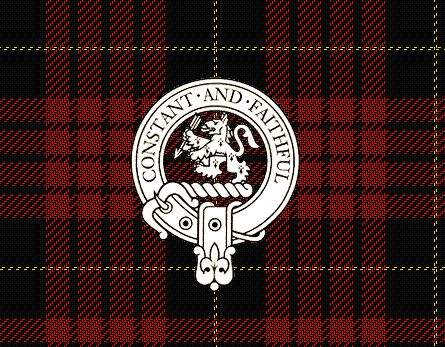
The name McQueen (or MacQueen) has two separate derivations.
In the first instance the name comes from the old Norse name of Svienn or Sweyn and this line of McQueens would appear to have come from the same stock as the Clan Donald of Skye. It is known that Macsweyns held land in Skye from as early as the 13th century.

A second line is derived from Mac Suibhne (from the gaelic Suibhne meaning "going well") or 'Mac Sween'. In the 13th century, Suibhne was Lord of Knapdale and held Castle Sween. However this second McQueen branch was later largely absorbed by the neighbouring McMillans and Lamonts and it is uncertain to what extent they contributed to the present McQueen line.
There have been a number of large-scale movements of McQueens over the years.
Around the year 1400 a Moira MacDonald from Skye married Malcolm Beg, 10th Chief of
Mackintosh (who held lands south of Inverness), and those accompanying the
bride included a number of McQueens. Among these was a Revan McQueen, who
reputedly fought under Mackintosh at the battle of Harlaw in 1411. At that
time the lands of Corrybough on the river Findhorn, some 4 miles from Moy,
were owned by the Mackintosh and this became the new home of the "Revan McQueen"
group. In 1609, a Donald MacQueen of Corrybrough signed a bond of manrent
along with the chiefs of the other tribes composing the clan Chattan, binding
themselves to support Angus Mackintosh as their captain and leader. At this
period the "Corrybrough" MacQueen comprising twelve distinct families,
all landowners in the counties of Inverness and Nairn. Some of these lands
appear to have been held until the death the clan
chief, John Fraser MacQueen, in 1881. The title passed to his brother,
whose son emigrated to New Zealand and was the last known chief of the clan.
The crest and motto shown above are those of the last established chief of
Clan Revan MacQueens (as, presumably, is the tartan).
The next great movement occurred around 1600 when, in response to the "plantation" policies of King James II, large numbers of Scottish lowlanders were brought to Northern Ireland to repopulate areas devastated by war. The land was good and largely unfarmed, as the native Irish economy had been pastoral rather than arable. Settlers were encouraged by the promise of long leases, far better than the unfavourable terms in their native Scotland. It is estimated that, by 1640, at least 100 000 Scots had settled in Ulster, including a number of McQueens. As well as new modes of farming, the Scots brought a strict Calvinist doctrine, which by the late 1630s was taking a firmly Presbyterian shape and which, a century later, was to cause a clash with the Anglican High Church policies of the British monarchy.
Mounting religious pressure and escalating land rentals towards the end of the 1600s resulted in a number of "Irish Scots" returning to Scotland, with many settling around Glasgow and along the west coast of Ayrshire, almost within sight of Ulster. Church records show that in the early 1700s there were a number of McQueen families in this area and it can be assumed that many of them were returned settlers from Ulster.
By 1710 most of the farm leases granted to the remaining settlers in Ulster had expired and new leases were withheld until the tenants agreed to pay greatly increased rents. Rather than submit to these new conditions whole communities, led by their ministers, began to take ship for the Americas: a new exodus had begun.
Meanwhile, in the Hebrides, McQueens continued to hold the lands of Garafad in Skye as they had for many generations. However economic conditions remained poor and it was from this area that there was yet another large-scale exodus of McQueens across the Atlantic in the late 1700s and first half of the 1800s.
Today a glance at world-wide telephone directories will show that the relatively few McQueens still living in Scotland are greatly outnumbered by those in the United States, Canada, New Zealand, Australia - and South Africa (the home of this webmaster).
![]()
![]()
or return to Top of this section.
![]()